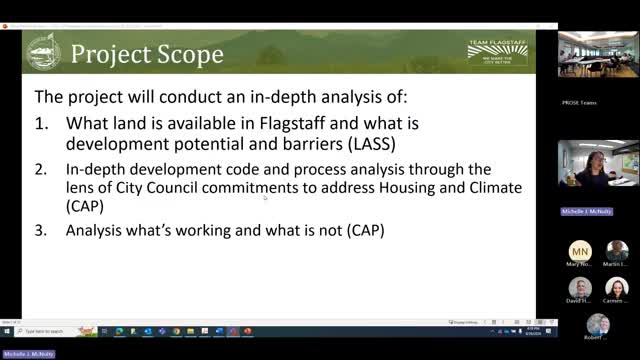City plans bold housing strategy to tackle development barriers
August 27, 2024 | Flagstaff City, Coconino County, Arizona
This article was created by AI summarizing key points discussed. AI makes mistakes, so for full details and context, please refer to the video of the full meeting. Please report any errors so we can fix them. Report an error »

In a recent government meeting, city officials discussed the critical need for a comprehensive analysis of land availability and development potential in Flagstaff. The focus was on identifying suitable land for housing development while addressing barriers posed by existing codes and regulations.
The meeting highlighted the importance of evaluating both vacant and underutilized properties within the Metropolitan Planning Area (MPO). Officials reported approximately 8,125 acres of vacant land across 2,242 parcels, with about 600,735 acres zoned for residential use. Additionally, there are around 5,400 acres of underutilized land, defined as developed sites with a value of 10% or less compared to the land value.
Environmental constraints were also a significant topic, with 13% of the vacant land identified as having limitations due to factors like stream corridors and wetlands. This analysis did not account for tree resources, which could further reduce the amount of buildable land by up to 50%. The discussion underscored the necessity for rezoning many areas, particularly those designated as rural or state residential, to facilitate higher density housing development.
City officials identified 50 potential opportunity sites for further study, emphasizing the need for a balanced approach to redevelopment and new development to mitigate gentrification and displacement issues. The meeting also addressed the importance of aligning housing production with sustainability goals, ensuring that new developments do not compromise community values.
A significant part of the discussion revolved around the ongoing Code Analysis Project (CAP), which aims to identify barriers within the current development codes that hinder housing production. Initial findings indicated that existing review procedures and zoning regulations are slowing down development, necessitating a reevaluation of these processes to better support housing needs.
The meeting concluded with a commitment to further analyze the zoning codes and development standards to enhance housing affordability and sustainability, while also considering the community's environmental goals. The city plans to engage with various stakeholders to refine these proposals and ensure community buy-in for any future changes.
The meeting highlighted the importance of evaluating both vacant and underutilized properties within the Metropolitan Planning Area (MPO). Officials reported approximately 8,125 acres of vacant land across 2,242 parcels, with about 600,735 acres zoned for residential use. Additionally, there are around 5,400 acres of underutilized land, defined as developed sites with a value of 10% or less compared to the land value.
Environmental constraints were also a significant topic, with 13% of the vacant land identified as having limitations due to factors like stream corridors and wetlands. This analysis did not account for tree resources, which could further reduce the amount of buildable land by up to 50%. The discussion underscored the necessity for rezoning many areas, particularly those designated as rural or state residential, to facilitate higher density housing development.
City officials identified 50 potential opportunity sites for further study, emphasizing the need for a balanced approach to redevelopment and new development to mitigate gentrification and displacement issues. The meeting also addressed the importance of aligning housing production with sustainability goals, ensuring that new developments do not compromise community values.
A significant part of the discussion revolved around the ongoing Code Analysis Project (CAP), which aims to identify barriers within the current development codes that hinder housing production. Initial findings indicated that existing review procedures and zoning regulations are slowing down development, necessitating a reevaluation of these processes to better support housing needs.
The meeting concluded with a commitment to further analyze the zoning codes and development standards to enhance housing affordability and sustainability, while also considering the community's environmental goals. The city plans to engage with various stakeholders to refine these proposals and ensure community buy-in for any future changes.
View full meeting
This article is based on a recent meeting—watch the full video and explore the complete transcript for deeper insights into the discussion.
View full meeting
